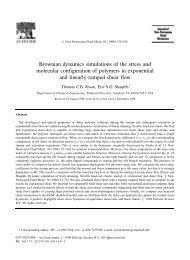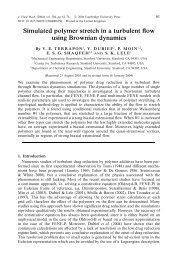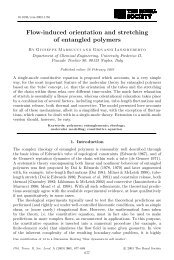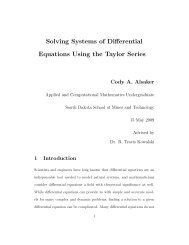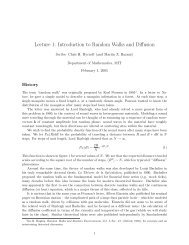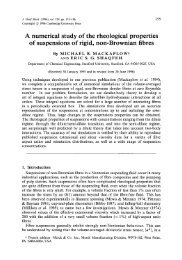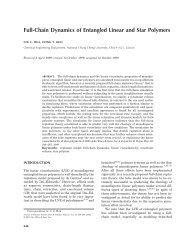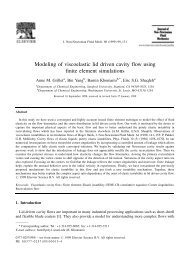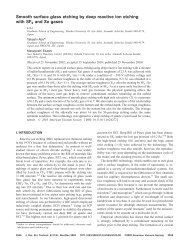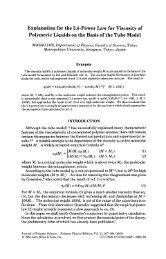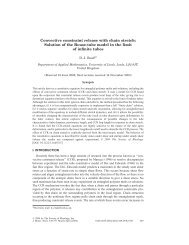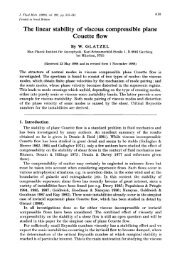Molecular modelling of entangled polymer fluids under flow The ...
Molecular modelling of entangled polymer fluids under flow The ...
Molecular modelling of entangled polymer fluids under flow The ...
You also want an ePaper? Increase the reach of your titles
YUMPU automatically turns print PDFs into web optimized ePapers that Google loves.
1.5. LINEAR RHEOLOGY 7<br />
1.5.1 Linear oscillatory shear<br />
Equation 1.5 can, in principle, be used to measure the relaxation modulus, G(t), directly.<br />
However, the step strain is never completely instantaneous so measured data at<br />
early times are unreliable and at long times the signal to noise ratio is weak, making the<br />
terminal behaviour difficult to obtain. A more effective approach is to use a continuous<br />
oscillating shear strain history. In complex notation this is expressed as<br />
γ(t) = R(γ max exp(iωt)). (1.9)<br />
Under this deformation history equation 1.5 gives<br />
σ xy (t) =<br />
∫ t<br />
−∞<br />
G(t − t ′ ) dγ<br />
dt ′ (t′ )dt ′ . (1.10)<br />
Substituting in the form <strong>of</strong> the oscillating shear history (equation 1.9) and changing<br />
the variable <strong>of</strong> integration gives<br />
(<br />
σ xy (t) = R iωγ(t)<br />
∫ ∞<br />
0<br />
)<br />
exp(−iωs)G(s)ds . (1.11)<br />
which can be rewritten as<br />
σ xy (t) = R (γ(t)G ∗ (ω)) . (1.12)<br />
where G ∗ (ω) is known as the complex modulus. Thus<br />
G ∗ (ω) = iω<br />
∫ ∞<br />
0<br />
e −iωt G(t)dt. (1.13)<br />
When the complex modulus is written as G ∗ = G ′ + iG ′′ it can be seen that G ∗ consists<br />
<strong>of</strong> a component which is in phase with the strain and one which is out <strong>of</strong> phase. <strong>The</strong><br />
in phase part, G ′ , is known as the storage or elastic modulus and the out <strong>of</strong> phase<br />
part, G ′′ , is the loss or dissipative modulus. A perfectly elastic solid <strong>of</strong> modulus G 0<br />
would have G ′ = G 0 and G ′′ = 0. In the case <strong>of</strong> a viscous liquid with viscosity η then<br />
G ′ = 0 and G ′′ = ωη since σ xy is in phase with the shear rate.<br />
For a viscoelastic<br />
material both G ′ and G ′′ are functions <strong>of</strong> the applied frequency, ω. In general, the<br />
loss modulus dominates at low frequencies, while the elastic modulus dominates at<br />
high frequencies. <strong>The</strong> material crosses over from viscous behaviour elastic behaviour at<br />
some intermediate frequency where G ′ = G ′′ . A simple form <strong>of</strong> the relaxation modulus,<br />
the Maxwell model, where G(t) = G 0 exp(−t/τ) which is characterised by a relaxation<br />
time, τ. <strong>The</strong> complex modulus for this model is given by,<br />
G ′ (ω) = G 0<br />
ω 2 τ 2<br />
1+ω 2 τ 2 , G ′′ (ω) = G 0<br />
ωτ<br />
1+ω 2 τ 2 . (1.14)



